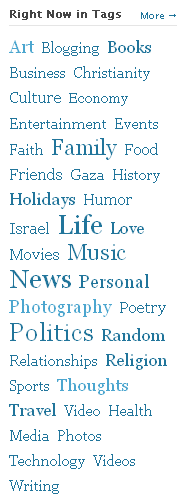What is tagging?
You may have heard folks talk about "tagging" or seen the word "tags" in connection to information on the web. Tagging is fast becoming a common way to organize information--basically, it just means attaching an identifying keyword, label, or category title to something, like a webpage, a file, or other content. Tagging is a kind of filtering, or sorting.
If you're looking at a webpage, and you see a bunch of words to the side of the page, they probably indicate "tag cloud" or a "tag index." Here's an example, from the home page of Wordpress--it shows the top tags being used at the time I took this picture.

Each of those words, and the size of the words, tells you about the content on that site. The tags tell you what topics people are writing about, and the size of the word gives you a relative sense of the number of items that have been tagged with the same word. The bigger the word, the more items have been identified with that tag. This can be a helpful visual description of what a website focuses on, and can give you a quick sense of whether that site has the kind of information you are looking for.
In most cases, when you see a tag cloud, you can click on the word and it will then link you to a list of all the content that is tagged with that word. Sometimes the tag cloud is static, and is therefore only a descriptive device, not a navigational tool.
Using tags: navigating, organizing, and discovering
Tags can be used in at least three ways. First, if you are visiting a site, and want to see what's there, you can click on words that interest you in the tag cloud, and access the content that way. You could think about that as "navigating through tags." For example, you can click on the tags in the right-hand navigation menu on this page, to access content with a particular label.
Second, there is a way to use tags that you could think about as "organizing through tags." This second way is more related to generating or organizing content, rather than looking to see how someone else has organized it.
Some blogging programs allow you to tag your posts, which are aggregated to create a tag cloud for your blog; the program I use, Squarespace, has a list of tags, instead of a cloud (see right-hand navigation menu). Another common way that people use tags to organize content is with web-based programs like Flickr (online photo albums) and Delicious (online bookmarking website). If I am surfing the web, and I have a Delicious account, I can bookmark webpages and tag them; if I collect hundreds of bookmarks, it's easier for me to organize that content by using tags rather than putting bookmarks into lots of folders.
Say I've spent a few days looking at non-profit organizations focused on hunger issues, and I've also been trying to figure out what my taxes might be this year so I saved a bunch of websites about tax calculators and tips on deductions...and I also am weaning my household off of toxic chemicals and using all "green", eco-friendly (and people-friendly) cleaning products, so I've been finding some information about that and bookmarking that too. If I've been tagging each site as I bookmark it with one or two keywords, then it's easy for me to go back to my Delicious account and click on the right tag, without scrolling through a long list, or having to put bookmarks into a system of folders. The other very cool thing about Delicious is that your account is on the web, not attached to a particular computer, so you can bookmark anything wherever you are, and access your bookmarks from any computer.
Finally, tagging can also be "social" (more on this in a future post), which means that many of these services allow you to share content with friends or the larger public, whichever you decide. This sharing capacity allows you to use tags to discover websites that other people have already found interesting, already bookmarked or tagged...it's like Googling something, but pre-filtered because the content has already been sifted and sorted. If you are on Flickr, and you want to find a picture of tornado, you can type in "tornado" into the search box, and Flickr will pull up all the photos that have been tagged with "tornado." If you are on Delicious, and search for everything that's tagged "Ani DiFranco," Delicious will pull up all the pages that have been bookmarked and tagged with that name.
An interesting neologism associated with social tagging is the notion of a "folksonomy"--like a taxonomy, or system of categorization, but a system that is created by masses of people. The categories themselves are generated by the people who are creating the content, and categories emerge as people use it.
A more recent twist on tagging is something called "geotagging," which is using a physical location, like longitude and latitude coordinates, as a tag. This can give you precise information about where something or someone might be, and can allow you to associate files or other data with specific locations. Google Earth allows you to post photos that are tagged with locations--creating an ever-growing, user-generated, photo enhancement of the satellite image of the world. Geotagging has interesting social applications--there are programs that can allow you to see what other people have written about a particular location when you are in that location, such as "Don't eat at this place!" or "Amazing sculpture near the river!" People can "tag places" just the way that they can tag websites, and mobile access to the web can allow us to see this additional layer of information about the world around us. (Good read: William Gibson wrote about geotagging as an artistic practice in his latest book, Spook Country.)